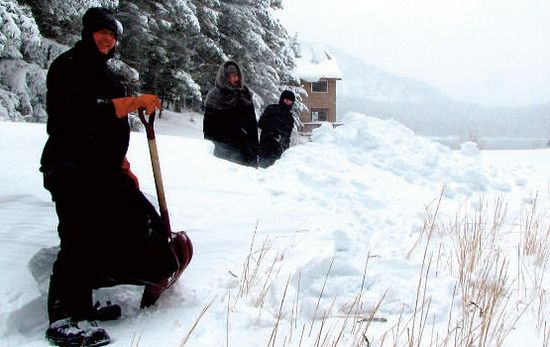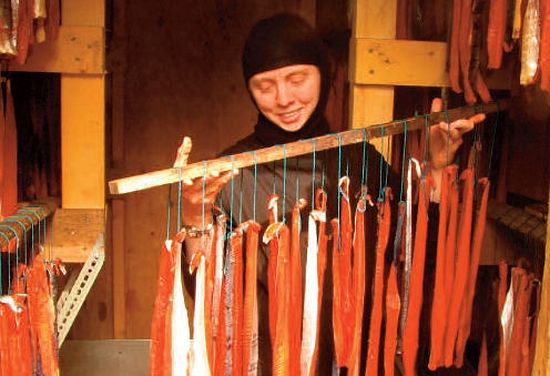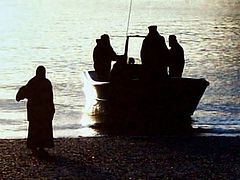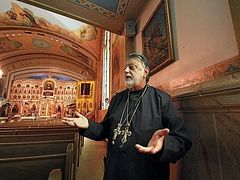Source: Orthodox Christian Network

The following excerpt is from the book Atlas of American Orthodox Christian Monasteries, by Alexei Krindatch and is now available through Holy Cross Bookstore.
St. Michael Skete on Spruce Island and St. Nilus Skete on St. Nilus Island
Compared to the nuns on St. Nilus Island, the monks at St. Michael Skete are somewhat more exposed to the outside world. In the last decade several Orthodox families (one with six children) have bought land and built their houses nearby, thus becoming regular attendees of worship services at the monastery. In many ways St. Michael Skete serves today as a “connecting point” for this small local Orthodox community.
Each of three monks at St. Michael Skete brings unique skills and experience into the life of their small brotherhood. In his past secular life, Fr. Andrew, the skete superior, spent significant time doing various construction, landscaping, and gardening works. Once a devoted surfer, he found it easy to become a fisherman and good skipper of the monastery’s small motorboat. He also likes to joke that “surfers make good monastics, because they are wellbalanced persons.” Fr. Adrian, the senior monk at the skete, has degrees in economics and photography. Before becoming a monk, for a time he lived outside the United States while working for IBM in London and teaching English in Japan. Fr. Lawrence, the junior member of brotherhood (he joined St. Michael about three years ago), served several years in the navy, where he learned land surveying before eventually earning a degree in engineering.
Being Orthodox monastics does not mean that the monks and nuns at St. Michael and St. Nilus separate themselves from the local wider non-Orthodox community. This is, after all, Alaska—the place where neighbors must be able to rely on each other’s help and support. When word got out that a summer gale had destroyed the nuns’ newly planted garden, a surprise work party of Kodiak locals arrived on the nuns’ beach, with new seedlings in hand, as well as materials for additional garden beds.
The town of Kodiak is also home to a Baptist mission, where young interns stay while preparing themselves to become religious missionaries. The mission directors frequently bring these interns on day visits to St. Michael and St. Nilus to expose them to the Orthodox faith and to community life; the interns help the nuns with various homesteading chores such as digging springs, chopping firewood, and so forth.
Some of St. Michael’s non-Orthodox neighbors occasionally attend worship services at the monastery and contribute to the skete’s communal meals on Sundays. On the Fourth of July, there is a potluck party for the local community on the beach at Sunny Cove, with readings on American history and the singing of traditional American songs. The monks always participate in this event.
There are also so-called “dinner boat tours” from Kodiak that sometimes include St. Nilus Island on their itinerary. The nuns welcome their non-Orthodox visitors and talk with them about monastic life.
In conclusion, a few words must be said about the local natural surroundings. The major geographic landmark on Spruce Island is the sixteen-hundred-foot-tall peak of St. Herman Mount. A climb to the peak via the steep and loose trail is possible only for the physically fit. A wrong step could lead to a fall through dense salmonberry bushes and alder patches. Generally, hikers should not go to the peak alone, and it is a good idea to bring a VHF radio or cell phone in case of emergency. Atop the peak a breathtaking 360-degree view of Spruce, Kodiak, Afognak, and Marmot Islands awaits. In 2006 the Kodiak community, with the help of a Coast Guard, erected a twenty-four-foot steel cross on the top of Mount St. Herman.
As the name suggests, Spruce Island is covered with Sitka spruce trees, sometimes reaching two hundred feet in height. Whether precariously balanced on the edge of a cliff or creating a forest canopy with their moss-covered branches, the spruce trees present a majestic picture. The beautiful but thorny devil’s club (known sometimes as “Alaskan ginseng”) is also prolific here. The bad news is that an encounter with it could be very painful, as its tiny spikes imbed easily in the skin, causing minor irritation. The good news is that an invigorating tea can be made from the roots of Alaskan ginseng, and naturalists claim that it can be used to treat many illnesses. When spring comes, the island turns into a verdant mosaic of irises, ferns, petrushki (beach lovage), sour dock, and many other plants. In July salmonberries cover the island, followed later by blueberries, elderberries, and high bush cranberries. In the past Alaskan natives used to mix berries with seal oil and reindeer fat to make a high-energy food. Known as aqutaq, it was used by hunters as a portable food source (think of modern energy bars). For mushroom lovers the end of summer and the early fall are the best times for a visit. A multitude of mushrooms emerge from beneath the thick moss of Spruce Island—including brown velvets, hedgehogs, angel wings, and chicken-of-the-woods. The last ones grow on the sides of trees in the huge, bright orange clusters of up to fifty pounds!

Spruce and St. Nilus Islands are havens for birds and bird watchers. Bald eagles, oystercatchers, and hermit thrushes are some of the many birds that can be seen. In May the puffins return for the summer, nesting on the cliffs of St. Nilus Island. As for marine wildlife, various types of salmon return to the Kodiak region to spawn throughout the summer: sockeye salmon from late May through early July, pink salmon from July through August, and coho salmon from late August through September. The waters here offer abundant fishing, and a charter boat can also take visitors fishing for halibut and king salmon.
In spring and fall grey and humpback whales pass Spruce Island as they follow their migration patterns. Summer visitors are almost guaranteed to see sea otters and seals. The land animals that inhabit Spruce Island include red foxes, black-tailed deer, beavers, and snowshoe hares.
Most people come to St. Michael and St. Nilus Sketes from May through September, when the air is warm and the seas are calmer, thus making the passage from Kodiak easier. Yet, even then trips are difficult to plan in advance because the weather is always unpredictable here. For visitors to St. Herman’s sites, the monks can help with transportation by boat from Kodiak to Spruce Island and can give a tour of Monk’s Lagoon. For those who wish to have a longer respite from the noise and stress of the modern world, both St. Nilus and St. Michael Sketes welcome guests into their secluded homes, in which they share common prayer, labor, and meals.




